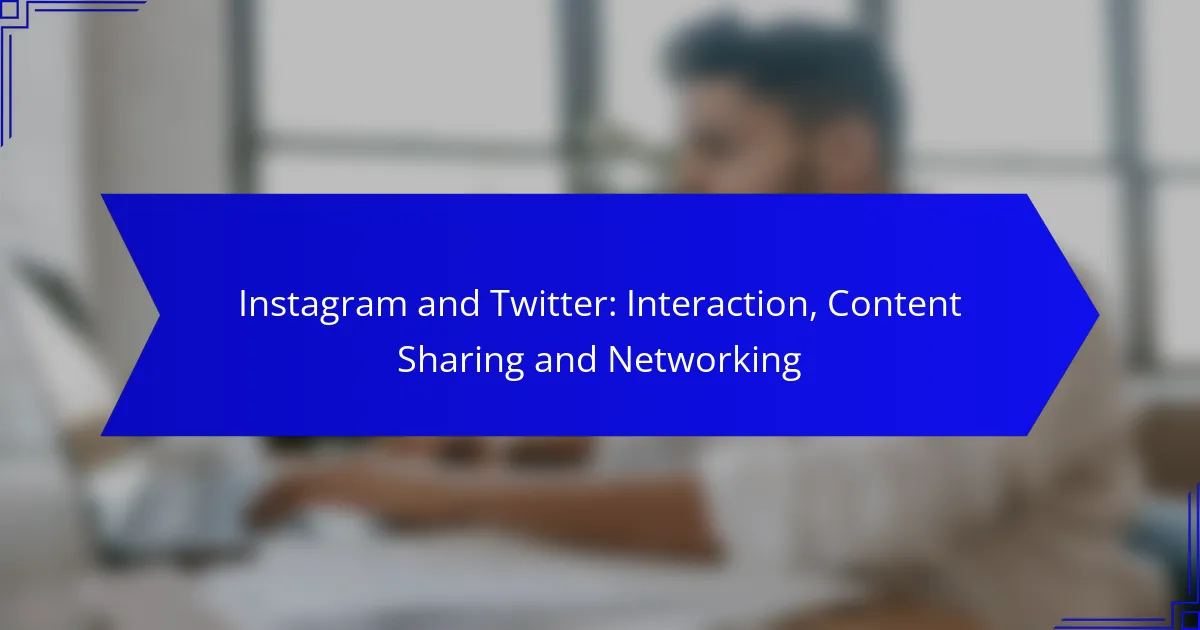Instagram and Twitter serve as powerful platforms for interaction, allowing users to engage in real-time communication and share content effortlessly. By leveraging effective content sharing strategies and fostering networking opportunities, individuals and businesses can enhance their online presence and build meaningful connections within a dynamic social environment.
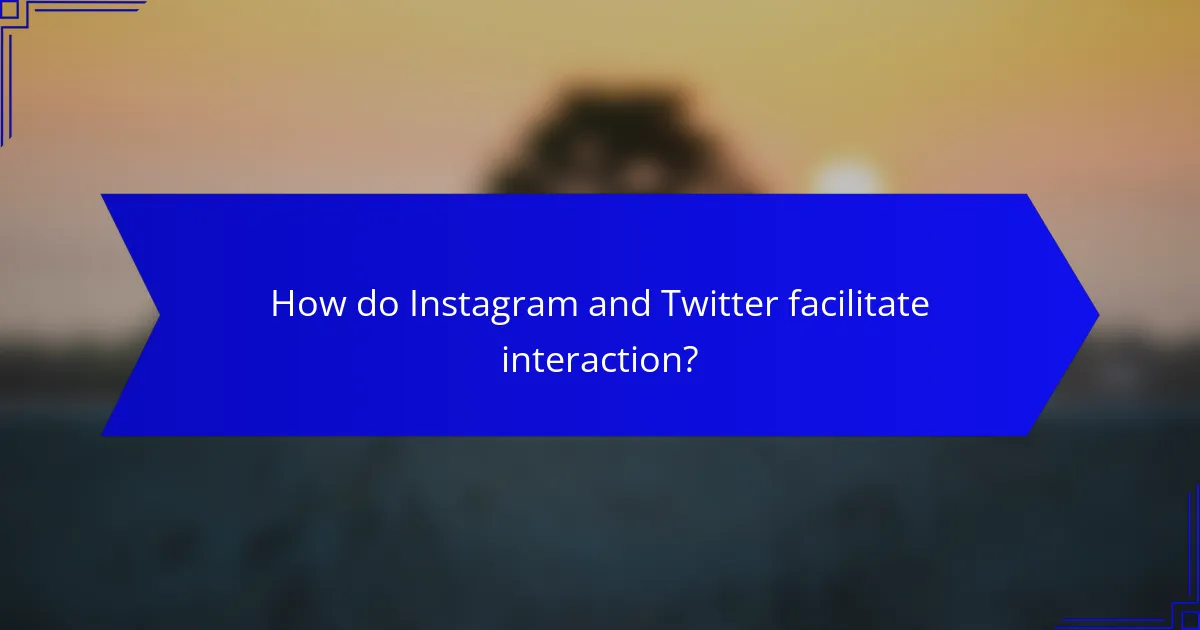
How do Instagram and Twitter facilitate interaction?
Instagram and Twitter enhance interaction through various features that promote real-time communication and engagement among users. These platforms enable users to connect, share content, and participate in discussions seamlessly, fostering a dynamic social environment.
Real-time engagement features
Both Instagram and Twitter offer real-time engagement features that allow users to interact instantly. On Twitter, users can tweet and retweet content, making it easy to share thoughts and updates as they happen. Instagram’s Stories feature enables users to post temporary updates that followers can view for 24 hours, encouraging immediate feedback and interaction.
These real-time features are particularly effective during live events or trending topics, where users can engage with each other and share their perspectives instantly. Utilizing hashtags on Twitter can further enhance visibility and interaction around specific events or themes.
Direct messaging capabilities
Direct messaging on Instagram and Twitter allows users to communicate privately, facilitating deeper conversations. Instagram’s direct messages support text, images, and videos, making it versatile for sharing content. Twitter’s DM feature also allows for multimedia sharing, but it is generally more limited in terms of group conversations.
To make the most of direct messaging, users should be mindful of their audience and maintain a respectful tone. Avoiding spammy messages and focusing on meaningful interactions can lead to stronger connections and networking opportunities.
Commenting and liking systems
Commenting and liking systems on both platforms encourage user interaction with content. On Instagram, users can like posts and leave comments, which can spark conversations and increase visibility. Twitter allows users to like tweets and reply directly, creating a dialogue around specific posts.
Engaging with content through likes and comments can help users build relationships and increase their reach. It’s beneficial to respond to comments and engage with followers to foster a sense of community and encourage further interaction.
Polls and questions for audience interaction
Polls and questions are effective tools for engaging audiences on both Instagram and Twitter. Instagram offers interactive polls in Stories, allowing users to gather opinions quickly. Twitter’s polling feature enables users to create simple surveys that followers can respond to directly in their feeds.
Using polls and questions can provide valuable insights into audience preferences and interests. Regularly incorporating these features can enhance engagement and make followers feel more involved in the content creation process.

What are effective content sharing strategies on Instagram and Twitter?
Effective content sharing strategies on Instagram and Twitter focus on maximizing visibility and engagement. Utilizing hashtags, promoting content across platforms, encouraging user-generated content, and timing posts strategically can significantly enhance reach and interaction.
Utilizing hashtags for visibility
Hashtags are essential for increasing content visibility on both Instagram and Twitter. By using relevant and trending hashtags, you can connect with a broader audience interested in specific topics. Aim for a mix of popular and niche hashtags to balance reach and engagement.
On Instagram, using around 10 to 15 hashtags per post is common, while on Twitter, 1 to 3 hashtags are typically sufficient. Always research current trends to ensure your hashtags are relevant and effective.
Cross-platform content promotion
Cross-platform content promotion involves sharing your Instagram posts on Twitter and vice versa to maximize audience engagement. This strategy allows you to leverage the strengths of each platform, reaching users who may prefer one over the other.
For example, you can share a teaser of your Instagram post on Twitter with a link directing followers to your Instagram profile. This not only drives traffic but also encourages followers to engage with your content across multiple platforms.
Leveraging user-generated content
User-generated content (UGC) is a powerful way to enhance authenticity and community engagement. Encouraging your audience to share their own content related to your brand can create a sense of belonging and loyalty.
Consider running contests or campaigns that invite users to post their experiences with your products, tagging your account. Highlighting UGC on your profiles not only showcases your community but also provides fresh content without additional effort.
Timing posts for maximum reach
Timing your posts effectively can significantly impact their reach and engagement. Both Instagram and Twitter have peak times when user activity is highest, typically during lunch hours and evenings on weekdays.
Utilize analytics tools to determine when your audience is most active. Experiment with posting at different times and track engagement rates to find the optimal schedule for your content. Aim for consistency to build a loyal audience that anticipates your posts.
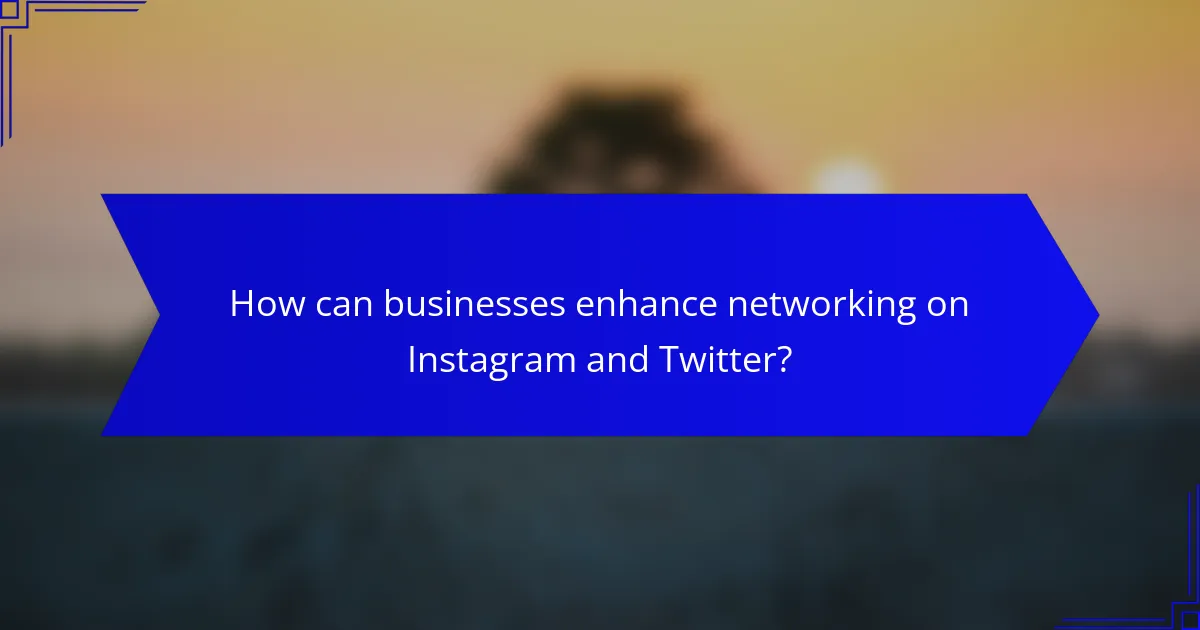
How can businesses enhance networking on Instagram and Twitter?
Businesses can enhance networking on Instagram and Twitter by actively engaging with their audience, collaborating with influencers, participating in trending conversations, and utilizing analytics for targeted outreach. These strategies help build a strong online presence and foster meaningful connections.
Building relationships through engagement
Engagement is key to building relationships on social media. Businesses should respond to comments, direct messages, and mentions promptly to show that they value their audience’s input. Regularly liking and sharing user-generated content can also strengthen connections and encourage further interaction.
Consider hosting Q&A sessions or live events to engage directly with followers. This not only boosts visibility but also creates a sense of community around the brand. Aim for consistent interaction to keep the audience engaged and invested.
Collaborations with influencers
Collaborating with influencers can significantly expand a business’s reach on Instagram and Twitter. Choose influencers whose audience aligns with your target market to ensure that the collaboration is effective. This can involve sponsored posts, product reviews, or joint giveaways.
When selecting influencers, consider their engagement rates and authenticity over sheer follower count. A partnership with a micro-influencer can often yield better results than a less engaged larger account. Establish clear goals for the collaboration to measure its success.
Participating in trending conversations
Joining trending conversations allows businesses to increase their visibility and relevance on social media. Monitor trending hashtags and topics to identify opportunities for participation. Crafting thoughtful responses or creating content that ties into these trends can attract new followers.
However, ensure that any participation aligns with the brand’s voice and values. Jumping on trends that don’t fit can backfire and alienate your audience. Use tools like Twitter Trends or Instagram Explore to stay updated on what’s popular.
Using analytics for targeted outreach
Analytics tools provide valuable insights into audience behavior, helping businesses refine their networking strategies. By analyzing engagement metrics, businesses can identify which types of content resonate most with their audience and adjust their approach accordingly.
Focus on metrics such as engagement rates, reach, and follower demographics to tailor content and outreach efforts. Regularly review analytics to track progress and make informed decisions about future campaigns. This data-driven approach can enhance networking effectiveness on both platforms.
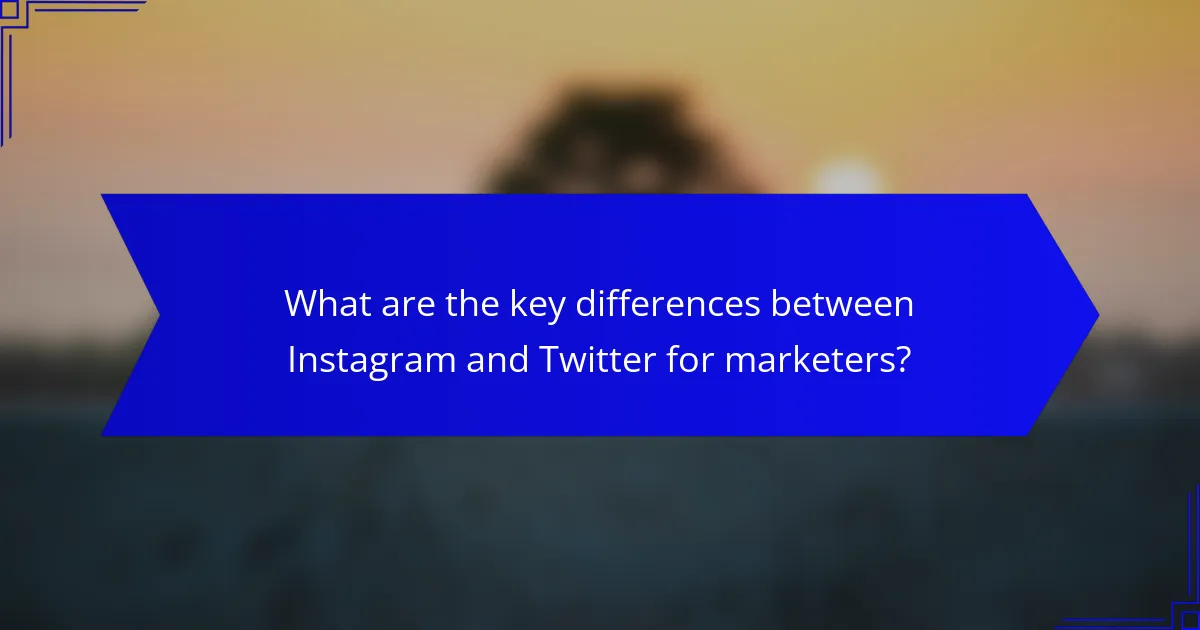
What are the key differences between Instagram and Twitter for marketers?
Instagram and Twitter serve different marketing purposes, with Instagram focusing on visual storytelling and Twitter emphasizing real-time text-based communication. Marketers must understand these distinctions to effectively engage their target audiences on each platform.
Visual content vs. text-based content
Instagram is primarily a visual platform, where high-quality images and videos capture user attention. Marketers should invest in compelling visuals to showcase products or services, as posts with strong imagery tend to receive higher engagement.
In contrast, Twitter thrives on concise text-based content, allowing brands to share updates, thoughts, and engage in conversations quickly. Tweets should be informative, witty, or provocative to stand out in a fast-paced feed.
Audience demographics and preferences
Instagram attracts a younger audience, with a significant portion of users aged between 18 and 34. This demographic is often more engaged with brands that utilize visually appealing content and storytelling.
Twitter, however, has a broader age range, appealing to both younger and older users. It is favored by professionals and news enthusiasts who prefer quick updates and discussions on current events, making it ideal for brands looking to establish authority or engage in trending topics.
Advertising options and formats
Instagram offers various ad formats, including photo ads, video ads, carousel ads, and stories ads, allowing brands to create immersive experiences. Marketers should consider using Instagram Shopping features to facilitate direct purchases from posts.
Twitter provides promoted tweets, trends, and accounts, focusing on driving engagement and visibility. Brands can leverage Twitter Ads to target specific audiences based on interests and behaviors, making it effective for real-time marketing campaigns.
Engagement metrics comparison
On Instagram, engagement is often measured through likes, comments, shares, and saves, with a focus on visual interactions. Marketers should aim for high engagement rates, as these can indicate strong audience connection and content effectiveness.
Twitter metrics include retweets, likes, replies, and mentions, emphasizing conversation and interaction. Brands should monitor these metrics to gauge sentiment and adjust their messaging in real time, ensuring they remain relevant and responsive to their audience’s needs.
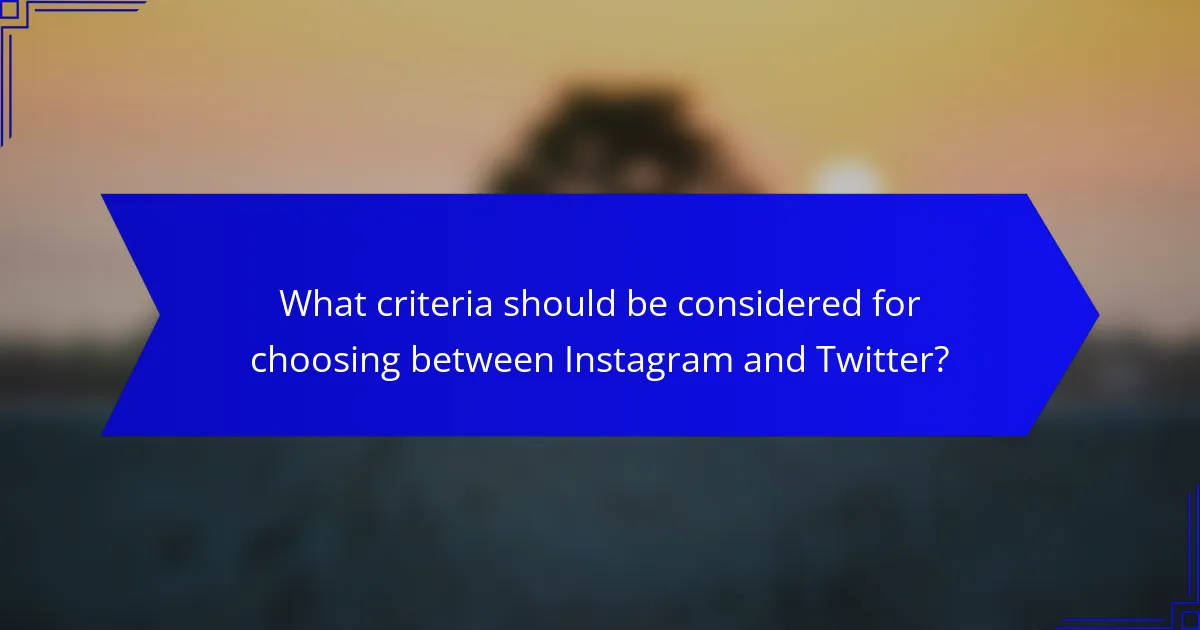
What criteria should be considered for choosing between Instagram and Twitter?
When choosing between Instagram and Twitter, consider your target audience, content type, and engagement style. Each platform has unique strengths that cater to different user preferences and marketing goals.
Target audience analysis
Understanding your target audience is crucial for selecting between Instagram and Twitter. Instagram typically attracts a younger demographic, with a strong focus on visual content, making it ideal for brands targeting millennials and Gen Z. In contrast, Twitter appeals to a broader age range, often favored by professionals and news enthusiasts who prefer concise updates and real-time interactions.
To analyze your audience effectively, consider their interests, online behavior, and the types of content they engage with. For example, if your audience is more inclined towards lifestyle, fashion, or travel, Instagram may be the better choice. Conversely, if your audience values news, opinions, or quick updates, Twitter could be more suitable.
